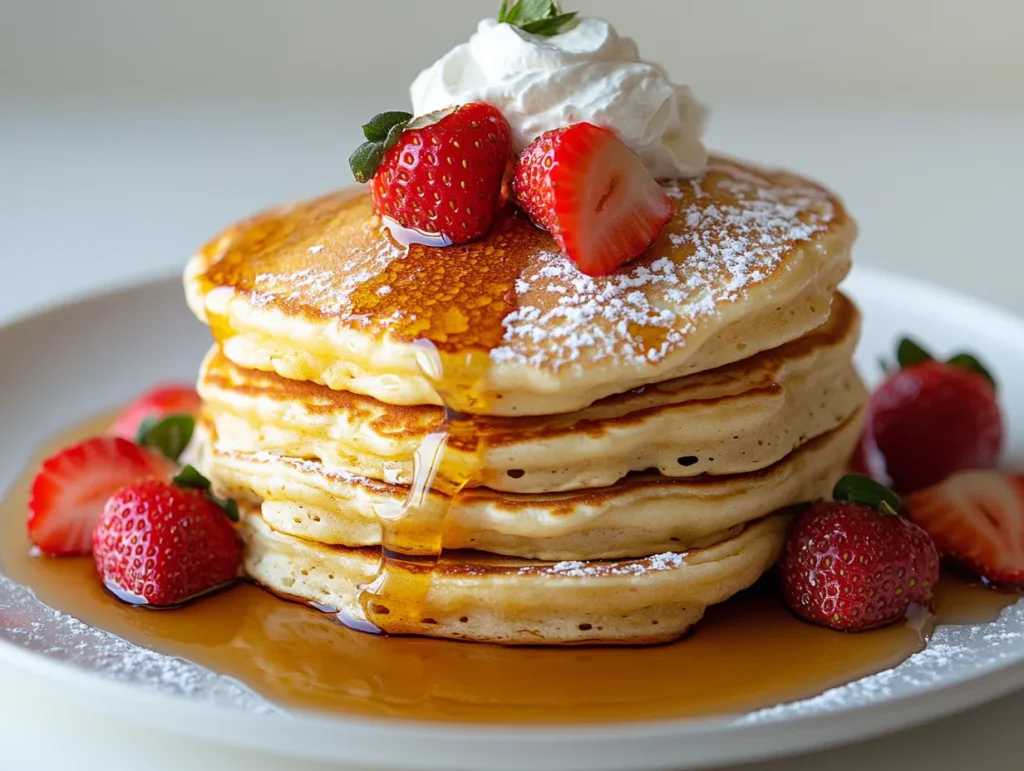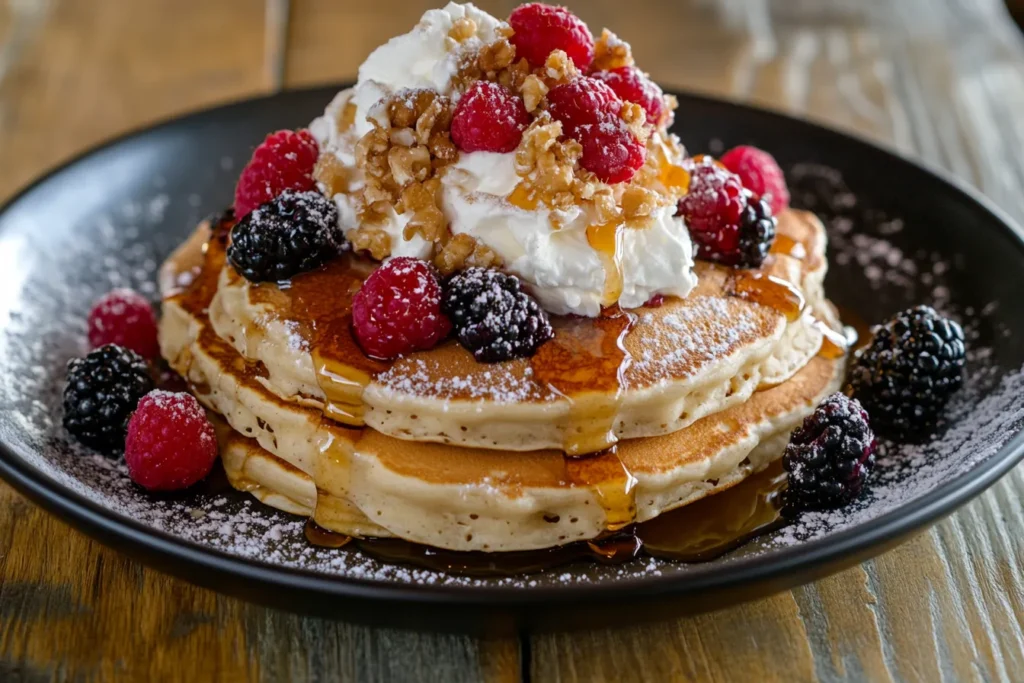Table of Contents
Why are restaurant pancakes so fluffy? This is a question many home cooks ponder while staring at their own, sometimes less-than-perfect, creations. The secret to achieving that light, airy texture often lies in a combination of ingredients, techniques, and a little bit of restaurant magic. Let’s explore the essential elements that contribute to those wonderfully fluffy restaurant pancakes.
The Science Behind Fluffy Pancakes
Pancakes are, at their core, a simple batter of flour, leavening agents, liquid, and fat. However, the magic happens in the interactions between these ingredients. Understanding these interactions is the first step to unlocking the secret to perfect pancakes (Why are restaurant pancakes so fluffy?).
The Role of Leavening Agents
Leavening agents, such as baking powder and baking soda, are responsible for the rise in pancakes. Baking powder is a complete leavening agent, containing both an acid and a base that react to produce carbon dioxide gas. Baking soda, on the other hand, requires an acidic ingredient like buttermilk or yogurt to activate. This carbon dioxide gas is what creates air bubbles in the batter, resulting in a light and airy texture (Why are restaurant pancakes so fluffy?).
The Importance of Mixing Techniques
Overmixing pancake batter can develop the gluten in the flour, leading to tough, flat pancakes. Restaurant chefs understand this and mix their batter just until the ingredients are combined. A few lumps are perfectly fine; in fact, they’re preferable to a smooth, overworked batter. Gentle mixing ensures that the gluten remains relaxed, resulting in tender pancakes.
Fat’s Contribution to Tenderness
Fat, whether it’s melted butter, oil, or even cream, adds richness and tenderness to pancakes. Fat coats the flour particles, preventing them from forming long, tough gluten strands. This results in a more delicate crumb and a softer texture. Furthermore, fat helps the pancakes brown evenly on the griddle (Why are restaurant pancakes so fluffy?).

Unveiling the Secret Ingredients
While the basic pancake recipe remains fairly consistent, some ingredients can significantly impact the final result. Restaurants often employ specific ingredients to enhance fluffiness and flavor (Why are restaurant pancakes so fluffy?).
The Power of Buttermilk
Buttermilk is a popular ingredient in many restaurant pancake recipes. Its acidity helps activate baking soda, creating extra lift. Buttermilk also adds a subtle tang that complements the sweetness of the pancakes. The acidic environment created by buttermilk also tenderizes the gluten, contributing to a softer texture (Why are restaurant pancakes so fluffy?).
The Magic of Separated Eggs
Separating the eggs and whipping the egg whites to stiff peaks before gently folding them into the batter is another restaurant secret. The whipped egg whites add a significant amount of air to the batter, resulting in incredibly fluffy pancakes. This technique requires a bit more effort, but the results are well worth it (Why are restaurant pancakes so fluffy?).
Club Soda: An Unexpected Addition
Some restaurants add a splash of club soda to their pancake batter just before cooking. The carbonation in the club soda creates extra air bubbles, leading to a lighter, more delicate texture. This is a simple yet effective trick that can make a noticeable difference.
Mastering the Cooking Techniques
The way pancakes are cooked can also affect their fluffiness. Restaurants often have specialized equipment and techniques that contribute to their perfect pancakes (Why are restaurant pancakes so fluffy?).
The Importance of Griddle Temperature
Maintaining the correct griddle temperature is crucial for achieving evenly cooked, fluffy pancakes. If the griddle is too hot, the pancakes will burn on the outside while remaining raw on the inside. If the griddle is too cool, the pancakes will be flat and dense. A temperature of around 350-375°F (175-190°C) is ideal.
The Art of the Flip
Knowing when to flip pancakes is essential for achieving a golden-brown color and even cooking. Wait until bubbles start to form on the surface of the pancakes and the edges begin to set. Gently flip the pancakes and cook for another minute or two, until golden brown on the other side.
The Benefit of Resting the Batter
Allowing the pancake batter to rest for 5-10 minutes before cooking allows the gluten to relax and the leavening agents to fully activate. This results in pancakes that are lighter and more tender. This is a step that is often skipped at home but religiously followed in professional kitchens.
Avoiding Common Pancake Mistakes

Many home cooks make common mistakes that prevent them from achieving restaurant-quality pancakes. Avoiding these mistakes is crucial for pancake success (Why are restaurant pancakes so fluffy?).
Overmixing the Batter
As mentioned earlier, overmixing the batter develops the gluten, resulting in tough pancakes. Mix the batter just until the ingredients are combined, leaving a few lumps. This is perhaps the most common mistake and the easiest to correct (Why are restaurant pancakes so fluffy?).
Using Old Leavening Agents
Baking powder and baking soda lose their potency over time. Using old leavening agents will result in flat, dense pancakes. Make sure your leavening agents are fresh for optimal results. A simple test is to add a spoonful of baking powder to hot water; if it fizzes, it’s still good.
Pressing Down on the Pancakes
Pressing down on the pancakes with a spatula while they’re cooking will deflate them, resulting in flat, dense pancakes. Resist the urge to press down and let the pancakes cook undisturbed.
Restaurant Secrets for Enhanced Flavor
Beyond fluffiness, restaurants often add special touches to their pancakes to enhance their flavor. These additions can elevate your homemade pancakes to a whole new level.
Vanilla Extract: A Simple Enhancement
Adding a teaspoon of vanilla extract to the pancake batter enhances the overall flavor and aroma. Vanilla extract complements the sweetness of the pancakes and adds a touch of warmth. This simple addition can make a big difference (Why are restaurant pancakes so fluffy?).
Citrus Zest: A Zesty Twist
Adding a teaspoon of citrus zest, such as lemon or orange zest, to the pancake batter adds a bright, refreshing flavor. Citrus zest pairs well with both sweet and savory toppings. The zest also releases aromatic oils that enhance the overall sensory experience.
Spices: Adding Depth and Warmth
Adding a pinch of spices, such as cinnamon, nutmeg, or cardamom, to the pancake batter adds depth and warmth. These spices complement the sweetness of the pancakes and create a cozy, comforting flavor (Why are restaurant pancakes so fluffy?).
The Importance of Quality Ingredients
Using high-quality ingredients can also contribute to the overall quality of your pancakes. Restaurants often source premium ingredients to create a superior product.
Using High-Quality Flour
Using high-quality flour, such as all-purpose or cake flour, can make a difference in the texture of your pancakes. Cake flour has a lower protein content, resulting in a more tender crumb. All-purpose flour is a good all-around option (Why are restaurant pancakes so fluffy?).
Using Fresh Dairy Products
Using fresh dairy products, such as milk, buttermilk, and butter, can enhance the flavor and texture of your pancakes. Fresh dairy products have a richer flavor and a smoother consistency.
Using Real Maple Syrup
While it may be tempting to use imitation syrup, real maple syrup is far superior in terms of flavor and quality. Real maple syrup has a complex, nuanced flavor that complements the pancakes perfectly. The superior taste justifies the higher cost (Why are restaurant pancakes so fluffy?).
Why are restaurant pancakes so fluffy? It’s a combination of understanding the science, using the right ingredients, mastering the techniques, avoiding common mistakes, and paying attention to the details. By following these secrets, you can create pancakes that are just as fluffy and delicious as those served in your favorite restaurant. Furthermore, experimentation can bring forth new combinations of ingredients and techniques to create truly unique and delicious breakfast foods.
Why Are Restaurant Pancakes So Fluffy? Exploring Different Recipes

While the principles remain the same, different restaurant pancakes might employ slightly different recipes for added variety and flavor profiles (Why are restaurant pancakes so fluffy?).
The Classic Buttermilk Pancake Recipe
Buttermilk pancakes are a staple in many restaurants. The acidity of the buttermilk reacts with the baking soda, creating a light and tangy pancake. This recipe often includes a bit of melted butter for added richness and tenderness (Why are restaurant pancakes so fluffy?).
The Light and Airy Soufflé Pancake
Soufflé pancakes are known for their incredible height and airy texture. These pancakes are made by whipping the egg whites to stiff peaks and gently folding them into the batter. This technique adds a significant amount of air, resulting in a pancake that resembles a soufflé.
The Sweet and Savory Cornmeal Pancake
Cornmeal pancakes offer a unique texture and flavor. The addition of cornmeal creates a slightly gritty texture and a subtle sweetness. These pancakes pair well with both sweet and savory toppings.
Beyond the Fluff: Unique Pancake Variations
Restaurants are constantly innovating, pushing the boundaries of traditional pancakes with creative and delicious variations. These unique takes offer exciting flavor combinations and textures, demonstrating the versatility of this breakfast staple.
Coffee-Infused Pancakes: A Morning Jolt
Adding coffee to pancake batter is a fantastic way to start the day. The coffee not only adds a rich, roasted flavor but also enhances the chocolate notes in any accompanying toppings like chocolate chips or cocoa powder. Experiment with different coffee strengths and types (espresso, cold brew) for varying levels of intensity (Why are restaurant pancakes so fluffy?).
Savory Herb and Cheese Pancakes
Pancakes aren’t just for sweet toppings! Savory pancakes, infused with herbs like chives, dill, or parsley, and cheeses like cheddar or Parmesan, offer a delightful alternative. Serve them with a fried egg or a dollop of sour cream for a satisfying and unique breakfast or brunch.
The Future of Pancakes: Innovation and Trends
The pancake is a dish ripe for innovation, and chefs are constantly finding new ways to reinvent this classic. From using alternative flours to incorporating global flavors, the possibilities are endless (Why are restaurant pancakes so fluffy?).
Alternative Flours: A Healthier Approach
Restaurants are increasingly using alternative flours like almond flour, coconut flour, or oat flour to cater to dietary restrictions and preferences. These flours offer unique flavors and textures while often being gluten-free and lower in carbohydrates.
Global Flavors: A Culinary Adventure
Incorporating global flavors into pancakes is another exciting trend. Think matcha pancakes from Japan, ricotta pancakes from Italy, or crepes from France. These variations offer a taste of different cultures and demonstrate the global appeal of pancakes (Why are restaurant pancakes so fluffy?)
FAQ
What are three types of pancakes?
Three common types of pancakes are buttermilk pancakes, known for their tangy flavor; soufflé pancakes, prized for their airy texture; and cornmeal pancakes, which offer a unique sweetness and slight grittiness.
Can I put coffee in pancake mix?
Yes, you can add coffee to pancake mix. It will add a subtle coffee flavor and can also enhance the color of the pancakes. Consider using strong brewed coffee or espresso for the best results.
What makes pancakes taste better?
Several factors can improve the taste of pancakes, including using high-quality ingredients, adding flavorings like vanilla extract or citrus zest, and using fresh dairy products. The type of cooking fat can also influence taste.

